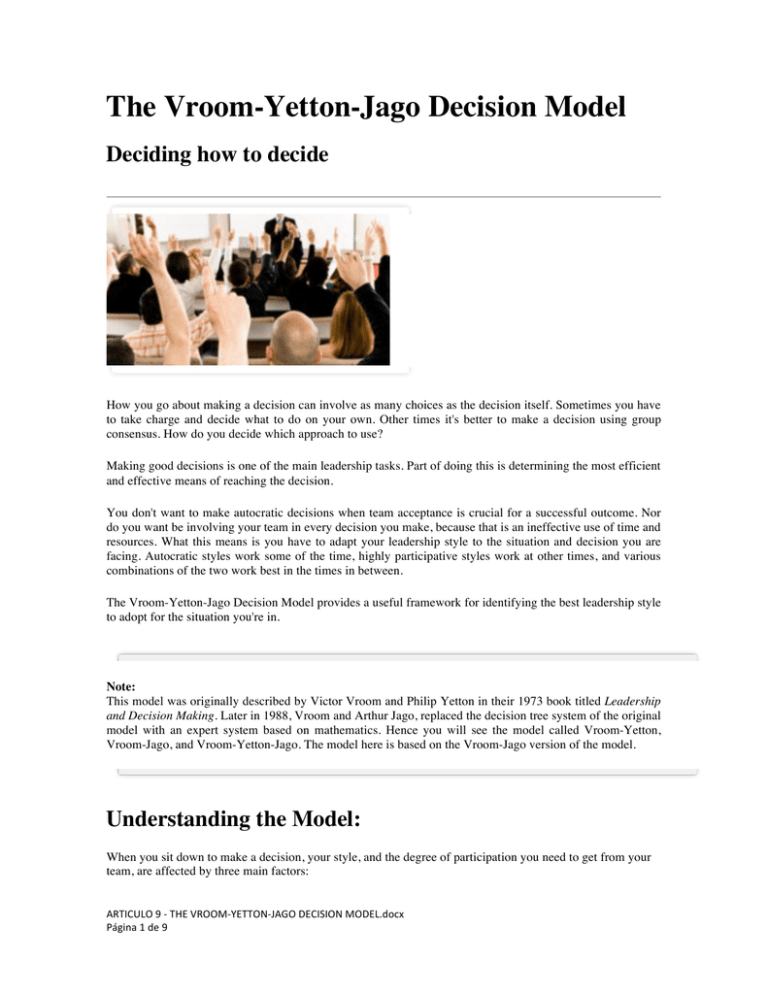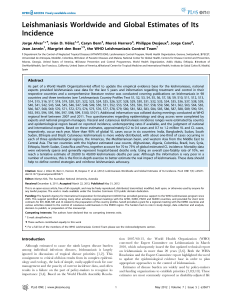ARTICULO 9 - THE VROOM-YETTON
Anuncio

The Vroom-Yetton-Jago Decision Model Deciding how to decide How you go about making a decision can involve as many choices as the decision itself. Sometimes you have to take charge and decide what to do on your own. Other times it's better to make a decision using group consensus. How do you decide which approach to use? Making good decisions is one of the main leadership tasks. Part of doing this is determining the most efficient and effective means of reaching the decision. You don't want to make autocratic decisions when team acceptance is crucial for a successful outcome. Nor do you want be involving your team in every decision you make, because that is an ineffective use of time and resources. What this means is you have to adapt your leadership style to the situation and decision you are facing. Autocratic styles work some of the time, highly participative styles work at other times, and various combinations of the two work best in the times in between. The Vroom-Yetton-Jago Decision Model provides a useful framework for identifying the best leadership style to adopt for the situation you're in. Note: This model was originally described by Victor Vroom and Philip Yetton in their 1973 book titled Leadership and Decision Making. Later in 1988, Vroom and Arthur Jago, replaced the decision tree system of the original model with an expert system based on mathematics. Hence you will see the model called Vroom-Yetton, Vroom-Jago, and Vroom-Yetton-Jago. The model here is based on the Vroom-Jago version of the model. Understanding the Model: When you sit down to make a decision, your style, and the degree of participation you need to get from your team, are affected by three main factors: ARTICULO 9 -­‐ THE VROOM-­‐YETTON-­‐JAGO DECISION MODEL.docx Página 1 de 9 • • • Decision Quality – how important is it to come up with the "right" solution? The higher the quality of the decision needed, the more you should involve other people in the decision. Subordinate Commitment - how important is it that your team and others buy into the decision? When teammates need to embrace the decision you should increase the participation levels. Time Constraints – How much time do you have to make the decision? The more time you have, the more you have the luxury of including others, and of using the decision as an opportunity for teambuilding. Specific Leadership Styles The way that these factors impact on you helps you determine the best leadership and decision-making style to use. Vroom-Jago distinguishes three styles of leadership, and five different processes of decision-making that you can consider using: Style: Autocratic – you make the decision and inform others of it. There are two separate processes for decision making in an autocratic style: Process: Autocratic 1(A1) – you use the information you already have and make the decision Autocratic 2 (A2) – you ask team members for specific information and once you have it, you make the decision. Here you don't necessarily tell them what the information is needed for. Style: Consultative – you gather information from the team and other and then make the decision. Process: Consultative 1 (C1) – you inform team members of what you're doing and may individually ask opinions, however, the group is not brought together for discussion. You make the decision. Consultative 2 (C2) – you are responsible for making the decision, however, you get together as a group to discuss the situation, hear other perspectives, and solicit suggestions. Style: Collaborative – you and your teamwork together to reach a consensus. Process: Group (G2) – The team makes a decision together. Your role is mostly facilitative and you help the team come to a final decision that everyone agrees on. Tip: This is a useful model, but it's quite complex and long-winded. Use it in new situations, or in ones which have unusual characteristics: Using it, you'll quickly get a feel for the right approach to use in more usual circumstances. To determine which of these styles and processes is most appropriate, there is a series of yes & no questions that you ask yourself about the situation, and building a decision tree based on the responses. There are seven questions in total. These are: ARTICULO 9 -­‐ THE VROOM-­‐YETTON-­‐JAGO DECISION MODEL.docx Página 2 de 9 1. Is the technical quality of the decision very important? Meaning, are the consequences of failure significant? 2. Does a successful outcome depend on your team members' commitment to the decision? Must there be buy-in for the solution to work? 3. Do you have sufficient information to be able to make the decision on your own? 4. Is the problem well structured so that you can easily understand what needs to be addressed and what defines a good solution? 5. Are you reasonably sure that your team will accept your decision even if you make it yourself? 6. Are the goals of the team consistent with the goals the organization has set to define a successful solution? 7. Will there likely be conflict among the team as to which solution is best? Use Figure 1 below to follow your answers through on the decision tree and identify the best decision process for your circumstances. Not that in some scenarios, you don't need to answer all of the questions. ARTICULO 9 -­‐ THE VROOM-­‐YETTON-­‐JAGO DECISION MODEL.docx Página 3 de 9 In general, a consultative or collaborative style is most appropriate when: • • • • You need information from others to solve a problem. The problem definition isn't clear. Team members' buy-in to the decision is important. You have enough time to manage a group decision. An autocratic style is most efficient when: ARTICULO 9 -­‐ THE VROOM-­‐YETTON-­‐JAGO DECISION MODEL.docx Página 4 de 9 • • • • You have more expertise on the subject than others. You are confident about acting alone. The team will accept your decision. There is little time available. Key points: The underlying assumption of the Vroom-Yetton-Jago Decision Models is that no one leadership style or decision-making process fits all situations. Analyzing the situation and evaluating the problem based on time, team buy-in, and decision quality can make a conclusion about which style best fits the situation. The model defines a very logical approach to which style to adopt and is useful for managers and leaders who are trying to balance the benefits of participative management with the need to make decisions effectively. ARTICULO 9 -­‐ THE VROOM-­‐YETTON-­‐JAGO DECISION MODEL.docx Página 5 de 9 The 7 questions 1. Is high quality important here or is a good solution absolutely critical? (is this a case where it would not be acceptable having lots of equal alternatives?) 2. As the leader, do you have enough information of your own to make a good decision? 3. Is the problem structured in that it is clearly defined, organized and has recognized solutions? 4. Do the members of the group have to accept this decision for it to work? 5. If you make this decision yourself, are you sure the group will accept it? 6. Are the group members aligned with the same goals that you are trying to achieve? 7. Is disagreement likely among group members in reaching a decision? Pro's • The Vroom-­‐Yetton-­‐Jago Decision-­‐making Model of Leadership is highly flexible with respect to the choices a leader can make in effecting decisions. The range is from highly dictatorial to democratic. • The method has a mechanical procedure to arrive at a decision making process. • The idea of a procedure like this can be seen as "objective", that the results were not arrived at by a non-­‐specific method. Con's • It is questionable whether this model can be used in large groups. • The decision procedure may be too mechanical and note take into account subtleties in decision making, such as changing emotions and, for that matter change, in general. • The questions may not be precise enough and sufficiently contextual, as in "Is the quality of the decision important?" "Important to whom or what and in what time frame" are the questions. ARTICULO 9 -­‐ THE VROOM-­‐YETTON-­‐JAGO DECISION MODEL.docx Página 6 de 9 Modelo Vroom-­‐Yetton-­‐Jago para la Toma de Decisiones La toma de decisiones acertadas es sin duda una de las actividades más importantes de un líder. Dado que las alternativas para abordar una situación particular pueden ser muy variadas, es importante determinar la forma más eficiente y efectiva para hacerlo. Personalmente he enfrentado diversas situaciones en las que no ha sido siempre claro si es mejor tomar las decisiones con la participación, e incluso el consenso de mi equipo de trabajo, o si lo más adecuado es tomar las decisiones por mi mismo. ¿Cuándo tomar un camino u otro? Encontré que el modelo Vroom-YettonJago provee un marco de referencia que permite identificar el estilo de liderazgo más adecuado de acuerdo a la situación. Este método fue propuesto en un inicio por Vroom y Yetton en 1973 y posteriormente se modificó por Vroom y Jago en 1988. Estudios subsecuentes han demostrado el modelo Vroom-Yago provee mayor precisión en el diagnóstico de la situación por lo que permite realizar una mejor elección de la alternativa para la toma de decisiones. El modelo Vroom-Yago distingue 5 situaciones diferentes en la toma de decisiones y propone un algoritmo para determinar cuál proceso es conveniente utilizar. Los 5 procesos • • • • • Autocrático I (A1) - Usted mismo soluciona el problema o toma una decisión usando la información disponible Autocrático II (A2) - Usted obtiene la información necesaria de los subordinados. Ellos pueden o no saber por qué necesita dicha información. Ellos no definen la situación ni las alternativas, usted decide cuál es la solución al problema. Consultivo I (C1) - Usted comparte en forma individual el problema con los subordinados relevantes, obtiene sus ideas y sugerencias, sin embargo usted toma la decisión final. Consultivo II (C2) - Usted comparte el problema con sus subordinados como un grupo, recopilando sus ideas y sugerencias. Nuevamente, usted toma la decisión final, que podría o no reflejar la influencia de sus subordinados. Grupo II (G2) - Usted, como líder, comparte la situación con sus subordinados como grupo. El grupo define alternativas y logra el ARTICULO 9 -­‐ THE VROOM-­‐YETTON-­‐JAGO DECISION MODEL.docx Página 7 de 9 consenso. Su meta es facilitar el proceso y ayudarlos a coincidir en la decisión final. Sus ideas no tienen un peso mayor que las de los demás. Las 7 preguntas El modelo Vroom-Jago provee una serie de siete preguntas, que se hacen en orden, para determinar cuál de los 5 procesos anteriores se debe utilizar. Se trata de un proceso descriptivo que permite avanzar en el diagrama a continuación para determinar cuál es el proceso más apropiado en una situación determinada. 1. ¿Es importante una alta calidad o es absolutamente crítica una buena solución? 2. Como líder, ¿tiene usted suficiente información para tomar la decisión por sí mismo? 3. ¿Está el problema estructurado de forma que está claramente definido, organizado y tiene soluciones reconocidas? 4. ¿Los miembros del equipo deben aceptar la decisión para que funcione? 5. Si toma la decisión por usted mismo, ¿está seguro que el grupo la aceptará? 6. ¿Están alineados los miembros del equipo con los mismos objetivos que usted trata de alcanzar? 7. ¿Es probable que haya desacuerdos en los miembros del equipo en la decisión a tomar? ARTICULO 9 -­‐ THE VROOM-­‐YETTON-­‐JAGO DECISION MODEL.docx Página 8 de 9 Considero que el modelo Vroom-Jagon es útil como una guía para la toma de decisiones en términos del nivel de involucramiento adecuado del equipo de trabajo dada una situación particular. Como apuntan los autores de este modelo, si bien no es conveniente tomar decisiones autocráticas cuando es crítico contar con la aceptación del equipo para lograr el resultado esperado, tampoco es adecuado involucrar al equipo en cada decisión pues conlleva un uso ineficiente de tiempo y recursos. ARTICULO 9 -­‐ THE VROOM-­‐YETTON-­‐JAGO DECISION MODEL.docx Página 9 de 9






